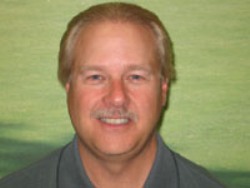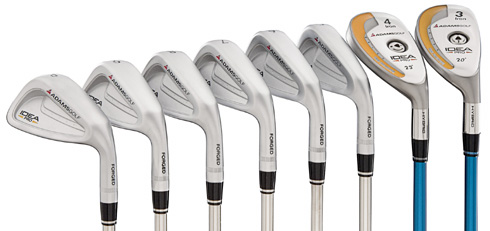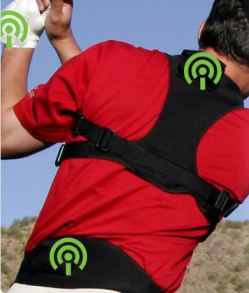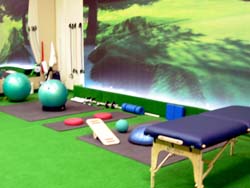 Andy Thompson is the owner of Totally Driven Golf based in Oakdale, MN. Totally Driven is an all-in-one golf facility that incorporates a complete analysis of your golf game, including club fitting and repair, instruction, and a fitness assessment conducted by a Titleist Performance Institute certified trainer.
Andy Thompson is the owner of Totally Driven Golf based in Oakdale, MN. Totally Driven is an all-in-one golf facility that incorporates a complete analysis of your golf game, including club fitting and repair, instruction, and a fitness assessment conducted by a Titleist Performance Institute certified trainer.
Totally Driven uses the latest in golf fitting technology to ensure your equipment is tailored specifically to you. Putter fittings include technology from Science and Motion Golf and the Edel Putting Fitting System while full-swing analysis uses launch monitors and the K-Vest.
TST: What are your thoughts on the new geometric (square and triangular) drivers that have come on the market this year? Should we believe the hype of longer and straighter drivers promised by these strange new shapes?
Andy: The new square and triangular driver shapes make sense as they increase the MOI (Moment of Inertia) of the club, which helps reduce twisting of the head at impact.
 As usual the “hype” is focused on the driver head. The shaft and head combination are the key. Having the right loft, face angle and shaft with correct flex, flex point, length, weight and grip size will make an impact much more than having a square driver that is not suited to you. Square or triangular alone will not help you to hit the ball straight.
As usual the “hype” is focused on the driver head. The shaft and head combination are the key. Having the right loft, face angle and shaft with correct flex, flex point, length, weight and grip size will make an impact much more than having a square driver that is not suited to you. Square or triangular alone will not help you to hit the ball straight.
TST: Do you think the newer driver technology helps the average golfer or have we reached a point in which technological advances are more for the professional golfer?
Andy: The new technology helps the average golfer more than the professional. A professional could get good results with just about anything as they have more ability to alter their swing than an average player.
TST: What graphite shaft technology do you see influencing golf in the next few years?
Andy: Some shaft manufacturers are able to create graphite shafts with low torque and yet have a more flexible tip. This is expensive and difficult to do, but has added value for some players.
TST: Driver technology seems to be something right out of NASA – it seemingly changes monthly – yet iron technology is largely unchanged in the last fifty years. What changes or improvements do you see in iron technology in the future?
Andy: You never know exactly what is on the horizon. Primarily as the public understands the need to be custom fit I would see manufacturers building more weighting options into their iron heads. Right now, only professional club-builders can alter swing weight, for example.
TST: Do you see any benefit for a lower handicap golfer to use a blade style iron?
Andy: Except slightly better workability, no other benefits. There are plenty of players cavity back irons that have similar feel and look the same from the top of the club.
TST: What are your thoughts on forged versus cast irons? Are there any benefits to playing one or the other?
Andy: This is personal preference. Forged clubs are more responsive (you can tell where you made contact on the face easier). Some people like this, others don’t. It is a myth that cast clubs are more forgiving. There are plenty of forged club designs that are very forgiving.
TST: Are blended golf sets with hybrids replacing the long irons here to stay or just a fad?

Andy: I don’t believe this is going to go away. It makes sense for most people. Hybrids are easier to hit the ball higher than long irons. Since manufacturers keep making lofts stronger and stronger, long irons have become more and more difficult to hit.
TST: What putter technology do you see influencing golf in the next few years? Do you prefer a putter with or without an insert?
Andy: Variable loft and weight options will be the next big thing, allowing you to change for speed of greens. Inserts are over-rated in my way of thinking. This does not affect skid or roll to much degree. Inserts only effect feel and sound.
TST: Describe the difference between a static and dynamic fitting. Which, in your opinion, is better?
Andy: First, very few people offer putter fitting of any kind. Dynamic fitting is always the best, but the fitter needs to have some pretty elaborate equipment in order to do this. A static fitting makes a lot of assumptions such as that you must have your eyes over the ball or stand a certain way.
Understanding loft and rise angle and how the golfer aims is very important and almost always missed. If your ball bounces instead of rolling properly, you don’t have the correct amount of loft on your putter. If you aim the putter right or left of the target, you now must pull or push the putt to make it. It’s a lot easier on the brain to aim straight and develop an appropriate stroke for this.
TST: Describe your fitting process. Why do you fit golfers this way?
Andy: First, we don’t assume someone needs new clubs. We spec out their current equipment and compare them to results from the launch monitor and dynamic fitting with impact tape. If their clubs are fine, we don’t try to sell them anything. We determine length, lie angle, swing weight, and shaft type dynamically.
 Almost nobody else does this. We are also able to connect a multitude of shafts and heads together so that we and the golfer can see results with different combinations on the launch monitor. For driver fits we look closely at launch angle, backspin rates, and ball speeds to help optimize distance. Also, face angle and weighting are considered to make sure the golfer is hitting the ball as straight as possible.
Almost nobody else does this. We are also able to connect a multitude of shafts and heads together so that we and the golfer can see results with different combinations on the launch monitor. For driver fits we look closely at launch angle, backspin rates, and ball speeds to help optimize distance. Also, face angle and weighting are considered to make sure the golfer is hitting the ball as straight as possible.
Static fitting is just a best guess. We have found plenty of people that fit into clubs longer or shorter than what a ruler measurement would show, for instance. The launch monitor data is invaluable for fitting someone as it is more reliable than the naked eye.
TST: What are some common golf equipment mistakes golfers make and what can be done to lessen or eliminate these mistakes?
Andy: Most golfers never get properly fitted for clubs. Club fitting should take at least an hour and the club fitter should be able to customize length, shaft type, swing weight, and lie angle for every club. Lie angles for irons should be determined for every club, not just based on a six iron. Because golfers often don’t get fitted, they regularly play clubs that are not suited for them.
TST: What are common mistakes golfers make when buying a putter?
Andy: Buying it off the rack, by looks, reputation or from making a few putts on the store’s putting green. Why adapt yourself to a putter? The putter should be fit to you, not the other way around.
TST: Do you recommend a putter that encourages an inside-straight-inside path or a straight-back, straight-through path?
Andy: You can make either type of stroke with virtually any type of putter. There are putters that are suited for either stroke, and that should be part of the fitting process. Either method can work. It is usually best not to try to change someone’s stroke in this regard unless they are really struggling.
TST: Describe your putting fitting process. Why do you fit golfers this way?
Andy: We first interview the golfer and then observe their stroke. Next we do an aim test with their current putter with a laser to determine how they aim left and right and it their loft is correct.

We have over 18 million combinations including length, hosel style, head type, lie angle, loft angle, scoring lines, and butt and head weights that can be put together very quickly to find a combination that the golfer can aim correctly with the right lie angle and loft. We don’t take any shortcuts.
Our fittings take an hour for woods or irons and we want to do as good of a job as possible for each golfer. There are plenty of others out there who do a pretense of a club-fitting, but ultimately just give the customer an off the rack set of clubs. We believe this is wrong.
TST: Golf fitness is a newer phenomenon that has really grown in the last ten years or so. Why do you think this? Do you think Tiger Woods had something to this?
Andy: Every sport has come to fitness as a way to improve. Golf has been the last sport to get there. Tiger and Annika have both had a lot to do with this. They have raised the bar and the awareness of golf conditioning to a new level.
TST: What lower cost exercise equipment do you recommend a golfer have in their garage or basement to help with getting into better shape?
 Andy: Swiss ball, elastic bands, medicine ball, and versa discs are all low cost options that have lots of uses.
Andy: Swiss ball, elastic bands, medicine ball, and versa discs are all low cost options that have lots of uses.
TST: Do you recommend a different workout regimen during a golfer’s off-season or should a golfer do the same routine (or a variation of) throughout the entire year?
Andy: There should be a slightly different regimen during the season, which would include more stretching and balance focus. You don’t want the golfer shortening muscles during the season.
TST: Do you recommend weight training to golfers and what should they focus on: increased muscle mass, flexibility, or a combination of both?
Andy: It depends on the golfer. Some need all and some need just flexibility and balance. Every person has different needs, strengths, goals, weaknesses, etc.
TST: How important is cardiovascular training to a golfer?
Andy: It’s important in order to have the same stamina level throughout 18 holes of golf, although golf is not an aerobic sport. It’s anaerobic.
 TST: Totally Driven is rare in that it incorporates golf fitness into the more traditional club fitting and instruction center. Do you see this “all-in-one” as the future of golf centers?
TST: Totally Driven is rare in that it incorporates golf fitness into the more traditional club fitting and instruction center. Do you see this “all-in-one” as the future of golf centers?
Andy: Absolutely. We believe we are at the start of the wave of the future. Every sport has moved in this direction. Golf is moving this way also.
Photo Credits: ©Totally Driven, ©Adams Golf, ©K-Vest, ©Totally Driven.

Good article. I find it especially interesting what he said about the benefits, or actually lack thereof, of the low handicapper playing forged blades. This is something I have believed a long time. I also like how he addressed putter fitting. It’s funny people get fitted for irons and woods then buy the most important club in their bag off the rack.
Nice article, Alan. Wish we had a facility like that here in the backwaters of the NYC area.
Even though I play cast cavity back’s, I think there’s something to playing a forged iron where you can feel the sweetspot so clearly. I think feeling it helps you find it more often. Here’s another perspective on forged vs. cast I thought interesting…
The Wedge Guy on blade vs. cavity back
Interesting link Jack. How would you judge the handicap level at which such a switch pays off. I suspect when your GIR reaches the 7-9 range or better? When you break 80 consistently? In my range avoiding the dreaded double rather than going for birdies seems to be the ticket.
I hope this type of fitting is the wave of the future. Less hype and more attention to how a club performs for you has to be a big plus.
Staff member Jeff Smith, a high teens handicapper, likes to play forged blades and more of a “player’s” iron than the forgiving clubs because he feels he can improve better. So, Allin, I would suggest that there’s no set “level.”
Cavity-back clubs may lower your scores instantly when you put them in your bag, but in my experience, my scores tend to slowly creep higher and higher (and higher than they were before with my forged irons) because I lose the all-important sense of feel and touch I have with forged, more muscle-back type irons.
So, I disagree quite strongly with Andy on that issue.
There are at least three threads (thread 1, 2, and 3) in our forum which discuss this issue.
Putter fitting is one of my frustrations with the whole putter market. There are a few exceptions to this rule. Yes and TaylorMade are manufacturers that offer interchangeable weighting options. Putter length and swing weight are important factors in a consistent putting stroke, I believe.
Good article. We use a wide variety of the equipment you use including K-vest and SAM. Its great to get accurate measurements rather than guessing. We have just added Trackman to our teaching studio which has helped compliment our other equipment.
I have just acquired a set of clubs with your name on them. I have never seen a set like these. Perimitor weighted with two red dots on each blade. Also have the woods – 1 – 5. Any help to identify these would be greatfully appreciated.
I drove 5 hours for a putter fitting with Andy in June. It was the best golf money I have ever spent. Prior to Andy’s instruction I would three and four putt most greens. I almost dreaded getting to the green in regulation knowing the yipes would take over. Now I expect to at least two putt the greens and to me putting has become the most fun part of the game. I am looking forward to attending one of Andy’s seminars on reading greens. At age 66 I have become addicted to golf again thanks to Andy.